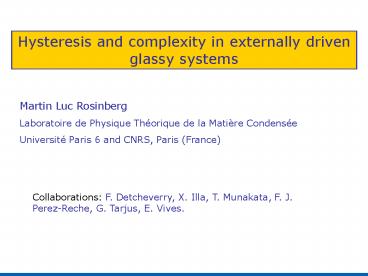Diapositiva 1 - PowerPoint PPT Presentation
1 / 20
Title: Diapositiva 1
1
Hysteresis and complexity in externally driven
glassy systems
Martin Luc Rosinberg Laboratoire de Physique
Théorique de la Matière Condensée Université
Paris 6 and CNRS, Paris (France)?
Collaborations F. Detcheverry, X. Illa, T.
Munakata, F. J. Perez-Reche, G. Tarjus, E. Vives.
2
Pseudo-elastic behavior
Acoustic emission
Strain-stress curve
3
Disordered ferromagnetic materials
- Magnetic hysteresis loop
- Barkhausen noise
4
Gas condensation in disordered porous solids
- Adsorption-desorption hysteresis loop
Avalanches Detcheverry et al., PRE 72,051506
(2005)
4He in silica aerogel (J. Beamish and H. Herman,
J. Low Temp. Phys. 134, 339, (2004))?
5
Common properties
- Rate-independent hysteresis
- Athermal behavior (gt T0 dynamics)?
- Jerky response (avalanches)?
- Systems are far from equilibrium on experimental
time scales and explore a complex (free-) energy
landscape. But the two driving protocols are
different
Free-energy
The two experimental protocols represent two
different ways of exploring the landscape
Configurational space
6
QUESTION
- What are the changes in the nonequilibrium,
hysteretic response (stress-strain curves,
magnetization-field curves, adsorption
isotherms,) when one controls - . the external intensive force (stress,magnetic
field, gas pressure...) - . or the extensive conjugated variable
(strain,magnetization,adsorbed quantity,???? - When are they identical ?
7
E. Bonnot et al. Phys. Rev. B 76, 064105 (2007)
8
Magnetic hysteresis loop when controlling the
magnetization
Si-Fe single crystal (from G. Bertotti
Hysteresis in magnetism )?
9
To explain the differences in the two
nonequilibrium responses, we need to understand
their relation to the distribution of the
metastable states in the H-m (or stress-strain)
plane.
Model Random-field Ising model (RFIM) at T0
(J. Sethna et al. PRL 70, 3347,1993).
introduced to study rate-independent hysteresis
associated to disorder-driven athermal
first-order phase transformations (e.g.
martensitic transitions, Barkhausen noise in
random magnets, etc..)?
H-J ?ltijgtsi sj ?i (Hhi)si with Jgt0
For hysteresis in the RFIM at finite T, using
local mean-field theory , see X. Illa et al.,
Phys. Rev. B 74, 224403 (2006)?.
10
Toy model Random field soft-spin model in the
mean field limit at T0
Continuous spin variables -1 lt si lt1
Mean field Hamiltonian H-?i(JmHhi)si ?i
V(si)?
g(h)?
11
H-driven protocol
Metastable states local minima of the
Hamiltonian ?H /? si0
ksiHJmhi k for sigt0 ksiHJmhi k for
sigt0
¾lt¾c ¾gt ¾c
12
M-driven protocol The system attempts to
minimize its internal energy U while satisfying
the constraint on the magnetization
U(si)- ?i(Jmhi)si?iV(si) with
?i siNm
Lagrange multiplier LU - ?i si
-Nm
One has to solve simultaneously the coupled
equations
? L/ ? si0 and ? L/? 0
and define an iterative procedure to go from a
metastable state with magnetization m to another
one with magnetization mdm
13
M-driven protocol
ksik mhi-(k/N)?i sign(si) - k for silt0 ksik
mhi-(k/N)?i sign(si) k for sigt0
(k-J)-(k/N) ?i sign(si)?
¾lt ¾c ¾gt ¾c
H
14
Relationship between hysteresis and complexity
Information about the distribution of the
metastable states in the H-m (or stress-strain)
plane in encoded in the quenched complexity
Q(m,H)?
For calculation of the complexity in the RFIM,
see F. Detcheverry et al., Eur. Phys. J. B 44,
327 (2005) F. J. Perez-Reche et al. Phys. Rev. B
77, 064422 (2008) M. L. Rosinberg et al. , J.
Stat. Mech. P10004 (2008) M. L. Rosinberg et
al., preprint cond-mat/0809.3774.
Calculation of Q(m,H) is in general complicated
but it becomes trivial in the mean-field limit.
In particular, the curve Q(m,H)0 is the
boundary of the domain of existence of the
metastable states in the H-m plane.
15
Large-disorder regime ¾ gt¾c
Q(m,H) gt0 in the dashed region no metastable
states outside the hysteresis loop because Jgt0
(Middleton no-passing rule no valid for spin
glasses)
16
Low-disorder regime ¾ lt¾c
Q(m,H) gt0 in the dashed region
17
Toy model conclusions
- When the H-driven (stress-driven) hysteretic loop
is smooth (large disorder), it coincides with the
M-driven (strain-driven) loop it is just the
envelope of the metastable states. - At low disorder,the macroscopic jump in the
H-driven loop is due to the presence of a gap in
the magnetization of the metastable states. - The M-driven (strain-driven) trajectory always
follows the boundary of the domain of existence
of the metastable states --gt reentrance at low
disorder
18
RFIM on a Bethe lattice (random graph) of large
connectivity z (MLR, Tarjus, Perez-Reche,
cond-mat/0809.3774)
Evolution of the envelope of the metastable
states in the H-m plane as z decreases
19
Behavior in finite dimensions (e.g. on a cubic
lattice) at low disorder (¾ ltlt ¾c)
1) Appearance of a yield field (stress)? and
strong fluctuations in the induced field 2) The
system self-organizes around the
pinning/depinning threshold for a flat
(self-affine) interface (see also F. Perez-Reche
et al. condmat/0807.3011)?
20
Conclusion
The (athermal, rate-independent) nonequilibrium
response is closely related to the shape ot the
domain of existence of the metastable states in
the field-magnetization (stress-strain)
plane. This shape changes with disorder. At low
disorder, this induces either a macroscopic
instability (H-driven protocol) or a reentrant
behavior (M-driven protocol). (Rem the
dynamical problem has been replaced by a purely
static calculation gt interesting for studying
the critical behavior no need for using the
Martin-Siggia-Rose formalism).































